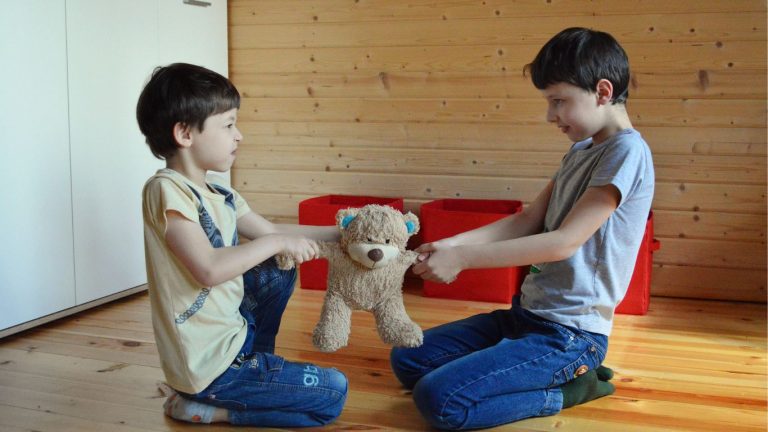This time of year typically means rather changeable weather and often clear windy days where I live, so what better thing to make than a kite? And what if kite making was cheap, easy and the kites actually fly really well? Well, here’s how to make a delta kite in 10 easy steps (your kids are going to love you for this one).
I still remember the excitement of flying kites when I was little. So I was really looking forward to reliving those memories. I think one of the best things about kids is being able to relive your own youth through their eyes.
When we started making the kite, a perfect wind was blowing, but unfortunately by the time we’d finished – nothing; perfect calm. Isn’t that always the way!
Never mind though, it was heaps of fun to make and my wee boy just loved chasing his Koro around with it. Now we’re just waiting for a windy day to test it out properly.
And that’s one of the biggest benefits of kites. They get you outside in windy, inclement weather. They make you seek out wide open spaces, like the beach, or a park. And they get you and your kids active and running about the place. Kites have family wellness written all over them!
What’s a delta kite?
The kite we made is called a delta kite. There is a bit more to making these than your traditional diamond kite. But I’ve always had much better flying results… and they were invented by NASA!
These triangular-shaped kites resemble the fourth letter of the Greek alphabet – Delta. Kite.org has this to say about delta kites:
Invented by NASA, a delta kite can flex and adjust to changes in the wind. The keel holds the spine straight and rigid. The ability to automatically adjust to changes in wind force and direction makes a delta a good beginner’s kite as well as a favourite of experienced fliers.
Once you’ve got your delta kite assembled (or you’re waiting for that windy day to arrive!), you should check out how to fly a kite like a pro. Chris Maxa, from Kite Loft, shows us the right way to do it:
Video courtesy: MonkeySee
In total, it cost me less than $20 to make one of these kites, and I had left over materials. That’s not too bad really. So let’s get into the instructions, and show you how to make one of these cool delta kites with your kids.
How to make a delta kite in 10 easy steps
You will need
- 1 metre nylon parka material – I bought mine from Spotlight
- Little metal rings about 10mm – I also bought these from Spotlight in the jewellery department, they were $3 for a packet
- 8mm dowel – this will be cut into 4 pieces, mine were roughly 54cm, 54cm, 42cm, 25cm
- String, or nylon
- Sewing machine
What to do
1. Mark out a 100cm baseline.
Mark out the large triangle which will form the main part of the kite, making sure to leave a 2cm margin along the baseline and a 4cm margin along the other 2 sides.
At the midpoint of the baseline, erect a 45cm line at right angles to the baseline. Join the end of this 45cm line to the ends of the baseline.
2. Cut out, making sure you don’t forget about the margins!
3. Mark out a smaller triangle 35cm x 17cm x 25cm, leaving a 2cm margin cut this triangle out.
4. Fold and sew the 2cm margin along the baseline.
Fold and sew the 4cm margins along the other sides, you need to leave enough room to slide the dowel into these two sides.
Measure 54cms up from the ends of the baseline and sew across the seam to stop the dowel slipping to the end.
Fold and sew along the 17cm and 25cm sides of the little triangle.
5. Fold the larger triangle in half along the baseline, slip the smaller triangle in so that the longest part is right along the centre with the 25cm side being closest to the baseline (see photos below). You now have a sandwich of 3 layers of material, sew the 3 layers about 1cm from the centre line. This will secure the small triangle to the larger one and leave a tube to put in a piece of dowel.
6. Measure and cut the dowel to fit into each side pocket and the centre one then sew the seams shut to stop the dowel from falling out.
7. Measure up from each corner of the baseline and make a small mark at 41cm just inside the seam. Sew 2 of the little rings onto these points. Sew the third on the tip of the small triangle.
8. The last piece of dowel is the removable cross piece, the ends need to be notched to receive the rings (see photo above). You don’t want this too rigid though, just tight enough so it won’t fall out. This will give you the flex you need for the kite to adjust to the wind.
9. Lastly, tie your string, or nylon, onto the ring on the smaller triangle and wind the other end around a winder. You can now decorate the kite as you wish, with stickers, or decals, or even some tiny LED lights if you want to try giving night flying a whirl!
Flying your delta kite
10. If the kite is a bit unstable, try moving the third ring back along the seam of the triangle. You might also want to check out the video above to get the low down on how to fly a kite.
Happy kite making, and hopefully happy kite flying too!
Check out this section for more great crafting ideas for kids. You might also be interested in our other Matariki crafts.









